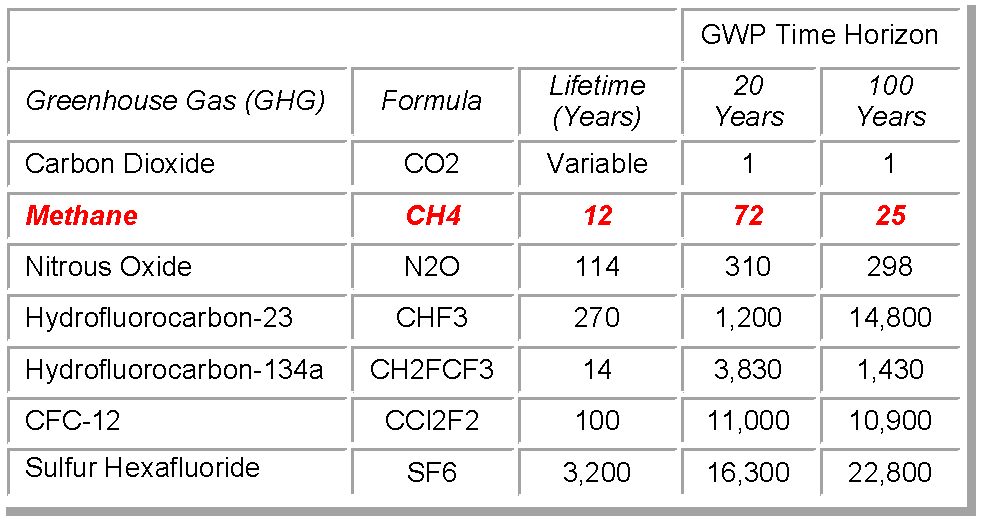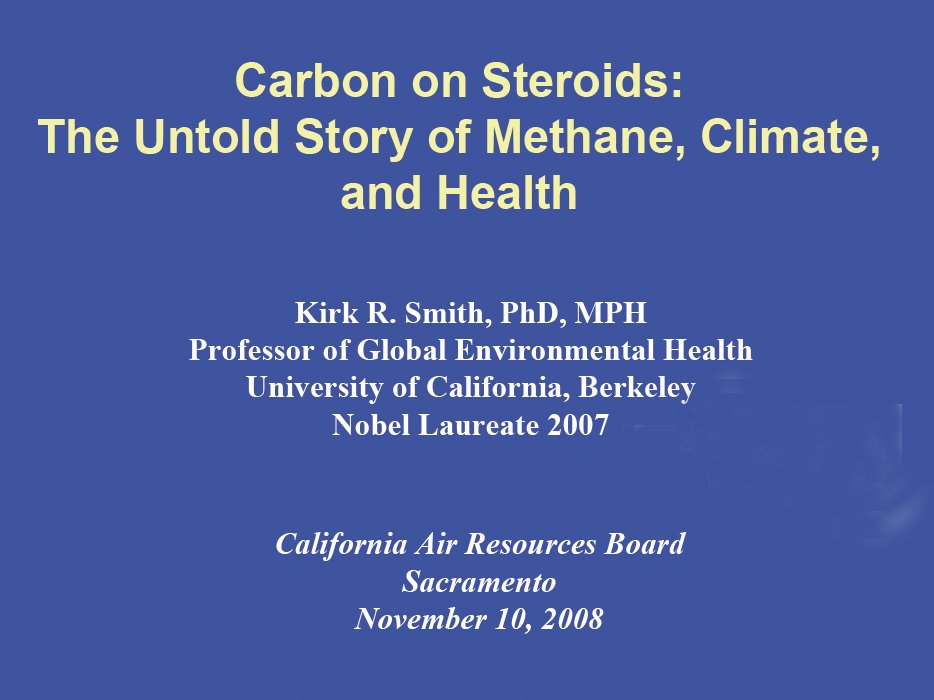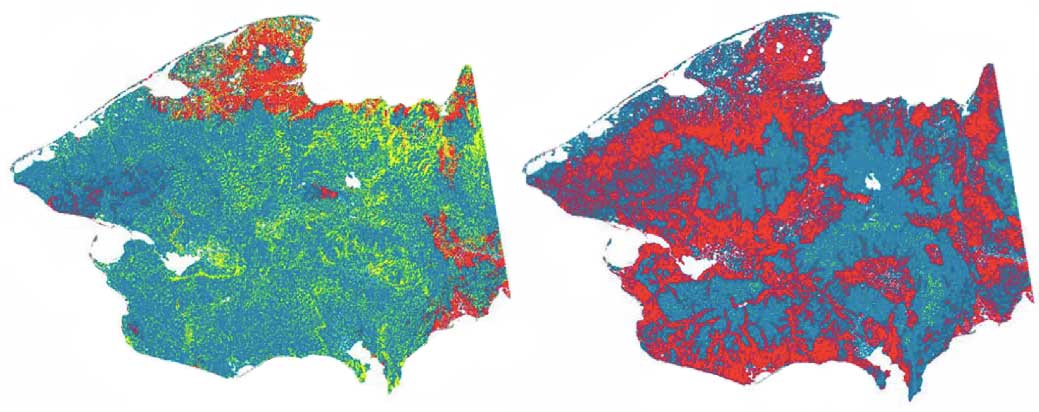Global Warming Forecasts - Permafrost
2020 - Melting Permafrost
2020 – 2030.
Time frame when irreversible climate tipping point is projected to
occur due to carbon outgassing from melting permafrost. “An
irreversible climate ‘tipping point’
could occur within the next 20 years [between 2010 and 2030] as a
result of the release of huge quantities of organic carbon locked away
as frozen plant matter in the vast permafrost region of the Arctic,
scientists have found. [What is a 'tipping point'?] Billions of tons of frozen leaves and roots
[containing carbon] that have lain undisturbed for thousands of years
in the permanently frozen ground of the northern hemisphere are thawing
out, with potentially catastrophic implications for climate change, the
researchers said."
"A study
into the speed at which the permafrost is melting suggests that the
tipping point will occur between 2020 and 2030 and will mark the point
at which the Arctic turns from being a net ‘sink’ for carbon dioxide
into an overall source that will accelerate global warming, they said.
. . . ‘Our research shows that the release of carbon from permafrost
will result in an irreversible climate tipping point in only 20
years...'
'Once the frozen carbon thaws out and decays, there is no way
to put it back into the permafrost,’ [Dr. Kevin Schaefer of the U.S. National Snow and Ice Data Center
in Boulder, Colorado] said.” (Steve Connor, Science Editor, “Melting of
the Arctic 'will accelerate climate change within 20 years', The Independent, Monday, May 30, 2011 reporting findings in Kevin Schaefer, Tingjun Zhang, Lori Bruhwiler, Andrew P. Barrett. Amount and timing of permafrost carbon release in response to climate warming, Tellus B, (Steve Connor, Science Editor, “Melting
of the Arctic 'will accelerate climate change within 20 years', The Independent, Monday, May 30, 2011 reporting findings in Dr. Kevin Schaefer, Tingjun Zhang, Lori Bruhwiler, Andrew P. Barrett. Amount and timing of permafrost carbon release in response to climate warming, Tellus B, 63: 165–180. doi: 10.1111/j.1600-0889.2011.00527.x, Volume 63, Issue 2, pages 165–180, April 2011)
See Methane potency ratings in Table at right.
See “Thawing Permafrost Study” video featuring commentary by Dr. Kevin Schaefer, NSIDC, CERES, February 16, 2011
2025 - Melting Permafrost
2025. Projected
starting point when melting permafrost begins a likely irreversible
release of 190 gigatons of greenhouse gases into the atmosphere. “Thawing permafrost
is threatening to overwhelm attempts to keep the planet from getting
too hot for human survival. Without major reductions in the use of
fossil fuels, as much as two-thirds of the world's gigantic storehouse
of frozen carbon could be released, a new study [Amount and timing of permafrost carbon release in response to climate warming]
reported. That would push global temperatures several degrees higher,
making large parts of the planet uninhabitable. Once the Arctic gets
warm enough, the carbon and methane emissions from thawing permafrost
will kick-start a feedback that will amplify the current warming rate,
says Kevin Schaefer, a scientist at the National Snow and Ice Data Center (NSIDC) in Boulder, Colorado."
"That will likely be irreversible. And we're less than 20 years [2030]
from this tipping point. Schaefer prefers to use the term ‘starting
point’ for when the 13 million square kilometres [11.6 million square
miles] of permafrost in Alaska, Canada, Siberia and parts of Europe
becomes a major new source of carbon emissions. ‘Our model projects a
starting point 15 to 20 years [2025 to 2030] from now ,’ Schaefer told IPS.
The model used a 'middle of the road' scenario with less fossil fuel
use than at present. Even at that rate, it found that between 29 and 60
percent of the world's permafrost will thaw, releasing an extra 190
gigatonnes of carbon by 2200. The study is the first to quantify when
and how much carbon will be released and was published this week
[February 15, 2011] in the meteorological journal Tellus.”
(Stephen Leahy, “Permafrost Melt Soon Irreversible Without Major Fossil
Fuel Cuts,” IPS, Uxbridge, Canada, February 17, 2011 reporting findings
in Kevin Schaefer, Tingjun Zhang, Lori Bruhwiler, Andrew P. Barrett, Amount and timing of permafrost carbon release in response to climate warming, Tellus B, 2011; DOI: 10.1111/j.1600-0889.2011.00527.x, article first published online on February 15, 2011)
2025. Approximate
year when more carbon emissions will begin being outgassed from Arctic
permafrost than carbon is taken up by the tundra. “[S]cientists
have documented significant melting of the underground permafrost, from
Alaska to eastern Siberia. The rising temperatures [in the Arctic] have
lengthened the growing season of the Arctic summer, which has increased
plant growth and the consequent uptake of carbon dioxide. However, by
around 2025 this will go into reverse and the thawing permafrost will
release more carbon than is being taken up by the tundra growing above
it, [Dr. Kevin Schaefer of the U.S. National Snow and Ice Data Center
in Boulder, Colorado] said." (Steve Connor, Science Editor, “Melting
of the Arctic 'will accelerate climate change within 20 years', The Independent, Monday, May 30, 2011 reporting findings in Kevin Schaefer, Tingjun Zhang, Lori Bruhwiler, Andrew P. Barrett. Amount and timing of permafrost carbon release in response to climate warming, Tellus B, 63: 165–180. doi: 10.1111/j.1600-0889.2011.00527.x, Volume 63, Issue 2, pages 165–180, April 2011)
2030 - Melting Permafrost
2030. Permafrost melting by 2030 could cause severe damage to Russian defense infrastructure, assets and resources. “Defense
infrastructure, including key airfields, oil storage facilities and
strategic oil reservoirs, could all be destroyed if the hard permafrost
covering the ground year-round across Russia's far north melts by 2030,
Russia's First Deputy Emergencies Minister Ruslan Tsalikov told the Federation Council,
the upper chamber of the Russian parliament, Thursday. Tsalikov
described as a catastrophe the damage that would result from widespread
permafrost melting, the RIA Novosti
news agency reported. Russia's widespread coniferous forests also
could be inundated by flooding and unprecedented warmer weather
triggered by climate change, Tsalikov said. If the annual temperature
rises by one or two degrees ... the permafrost could decrease 50
percent, Tsalikov said."
"The risk of flooding would also double, he said, according to the RIA
Novosti report. Global warming could also cost Russia its huge supplies
of methane gas trapped beneath the permafrost, believed to be almost
one third of the entire world's reserves, RIA Novosti said. The news
agency said West Siberia's permafrost was currently disappearing at the
rate of 4 centimeters per year. That would cause the permafrost's
southern boundaries to retreat by an average of nearly 50 miles across
northern Russia over the next 20 years [2010-2030], the report said.” (Martin Sieff, UPI News Service, “Russia Defense Watch: Melting ice menace,” UPI International Intelligence, June 23, 2008)
2030. Global warming
projected to add as much $6.1 billion in repair and replacement costs to
Alaska’s infrastructure by 2030. “Many of Alaska's roads,
runways, railroads and water and sewer systems will wear out more
quickly and cost more to repair or replace because of climate change,
according to a study released yesterday. Higher temperatures, melting
permafrost, a reduction in polar ice and increased flooding are expected
to raise the repair and replacement cost of thousands of infrastructure
projects as much as $6.1 billion for a total of nearly $40 billion -
about a 20 percent increase - from now to 2030, according to the study,
by the Institute for Social and Economic Research at the University of
Alaska Anchorage. . . .
The study is the first of its kind in
Alaska, and its authors emphasize that it does not project costs for
things like moving villages, protecting the Trans-Alaska Pipeline,
fighting wildfires or protecting private property that may be affected.
‘There are a million other issues related to climate change,’ said
Peter Larsen, a natural resource economist at the Institute for Social
and Economic Research and the lead researcher for the report.” (“Study
Sees Climate Change Impact on Alaska,” The
New York Times, June 28,
2007 citing findings in Peter Larsen,
Principal Investigator, O. Scott Goldsmith, ISER-UAA, Orson
Smith, UAA-Engineering, Meghan Wilson, ISER-UAA, Ken Strzepek, U. of
Colorado-Engineering, Paul Chinowsky, U. of Colorado-Engineering, and
Ben Saylor, ISER-UAA, Estimating
Future Costs for Alaska Public Infrastructure At Risk from Climate
Change, Institute of Social and Economic
Research, University of Alaska Anchorage, June 2007, pp. 1, 7, 69,
74, 81)
Projected Permafrost Distribution, Seward Peninsula, Alaska — Early 21st Century and Late 21st Century
(Yellow=Continuous; Blue=Discontinuous; Red=Thawing Permafrost/Permafrost Free)
Left (Early 21st century). Right (Late 21st century). Source: Peter Larsen et al, Estimating Future Costs for Alaska Public Infrastructure At Risk from Climate Change, Institute of Social and Economic Research, University of Alaska Anchorage, June 2007, p. 11. Impacts do not include greenhouse gas contributions from CO2 and methane emissions released from melting permafrost.
2200 - Melting Permafrost
2200. By 2200 an estimated 190 billion tons of carbon dioxide and methane is projected to have been released into the air due to melting of the Earth’s permafrost. “The study [Amount and timing of permafrost carbon release in response to climate warming] is the first global investigation of what will happen in a warmer world to the huge amounts of frozen plant matter that has remained undegraded in the soil since it was incorporated into the permafrost about 30,000 years ago. It also found that by 2200 about two-thirds of the Earth's permafrost will have melted, releasing an estimated 190 billion tons of carbon dioxide and methane into the air – about half of all the fossil fuel emissions of greenhouse gases since the start of the industrial revolution. ‘Our results indicate that, as the Arctic warms up, this frozen carbon will thaw out, allowing microbial decay to resume and releasing carbon into the atmosphere,’ said Kevin Schaefer of the U.S. National Snow and Ice Data Center in Boulder, Colorado.” (Steve Connor, Science Editor, “Melting of the Arctic 'will accelerate climate change within 20 years', The Independent, Monday, May 30, 2011 reporting findings in Kevin Schaefer, Tingjun Zhang, Lori Bruhwiler, Andrew P. Barrett, Amount and timing of permafrost carbon release in response to climate warming, Tellus B, 2011; DOI: 10.1111/j.1600-0889.2011.00527.x)
Methane and Melting Permafrost
Fire and Methane Emissions From Permafrost
Permafrost - U.S. Secretary of Energy Steven Chu
___________________________________________________
[A]wareness of methane leaks from permafrost is so new that it was not even mentioned in the seminal 2007 report by the Intergovernmental Panel on Climate Change. (1)
— Arthur Max, Bureau Chief
Associated Press, The Netherlands
November 2010
___________________________________________________

Permafrost impacts and policy questions:
- How will the rate of permafrost melting be impacted by the projected volume of smoke, deposition and accumulation of soot on permafrost surfaces resulting from predicted large scale global warming forest fires and the consequent higher heat absorption of the darker surfaced "dirty snow"?
- Are the latest permafrost melt rate projections based on the most recent forecasts for large-scale climate change wildfires? Do they include contributions of projected greenhouse gas emissions from annual wildfires?
- At what point does methane outgassing from melting permafrost pose significant risk of igniting large-scale combustible methane-fueled fires triggered by random lightning strikes or other causes?
- What are the probabilities of seasonal wildfires intersecting areas of high methane emissions?
- What impact will the heat from local permafrost wildfires have on the melt rate and methane seepage rate of melting permafrost?
- How long will methane-fueled fires last, given the large volume of methane embedded in permafrost?
- How will methane-fueled fires be managed and suppressed?
- Do we have the technology, assets and sufficient resources to manage and suppress large-scale methane-fueled wildfires?
- What are the risks of re-ignition of suppressed methane fires given the continual release of methane from melting permafrost?
- If global warming wildfires burn large areas of permafrost, leaving black charred surfaces on the burn site that absorb more heat than non-burned permafrost areas, how will this impact the permafrost melt rate?
- How will black-charred burn areas impact albedo and total heat-trapping potency?
- How will methane gases escaping from melting permafrost impact local aquifers, groundwater, rivers, lakes and the quality of water resources used as freshwater drinking water supplies?
- How will the large volume of escaping methane from melting permafrost impact the total greenhouse gas heat-trapping potency mix?
- How will it impact policymaker timetables for deploying capture, control and curtailment technologies and the implementation of management and containment strategies?
- How will forecast underestimates affect the magnitude of permafrost melt impacts?
Is there any risk of wildfires burning Arctic
tundra and melting permafrost today? Listen.
___________________________________________________
That permafrost took tens of thousands of years to form, but will melt in less than 200. (2)
___________________________________________________
Are the Consequences of Methane Emissions
Being Underestimated?

Video of Kirk R. Smith making the above PowerPoint presentation, Carbon on Steroids: The Untold Story of Methane, Climate, and Health, California Air Resources Board, Sacramento, California, November 10, 2008. Is methane more hazardous than carbon dioxide in the near-term?
(1) Arthur Max, Associated Press bureau chief, The Netherlands, “Leaking Siberian Ice Raises a Tricky Climate Issue,” ABC News, Chersky, Russia, November 21, 2010
(2) Dr. Kevin Schaefer, kevin.schaefer@nsidc.org, National Snow and Ice Data Center quoted in press
release, “Thawing permafrost will accelerate global warming in decades
to come, says new study,” National Snow and Ice Data Center, Boulder,
Colorado, February 16, 2011
________________________________________________
2000 | 2010 | 2013 | 2015 | 2020 | 2025 | 2030 | 2035 |2040 | 2050 | 2060 | 2070 | 2080 | 2085 | 2090 | 2100
Heat Waves Global Warming | Energy Workforce Shortages | Water Shortages | Methane Carbon Dioxide | Arctic Global Warming | Wildfires | Climate Change Cost
Global Warming Underestimated | CO2 CH4 | Permafrost | Global Warming Sea Levels Rising | Sea Level Rise Maps | Global Warming Deaths
Melting Ice Caps | Kilimanjaro Melting | China Global Warming | Climate Refugees
